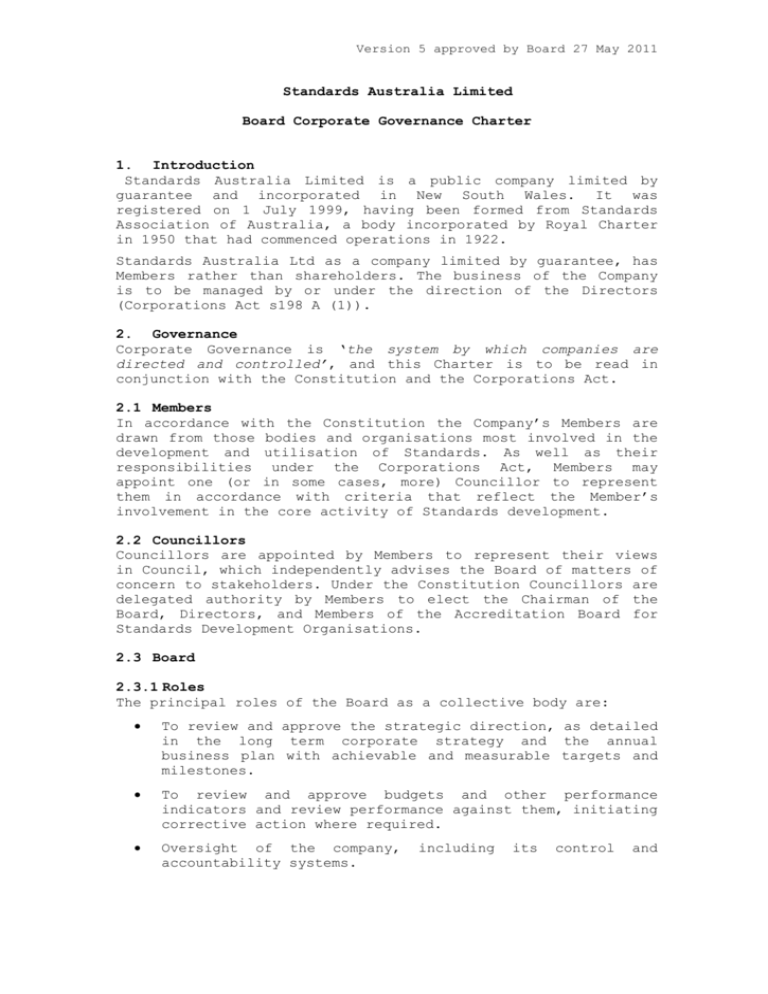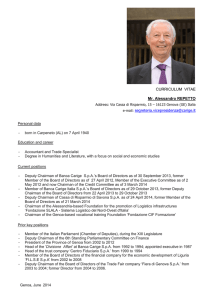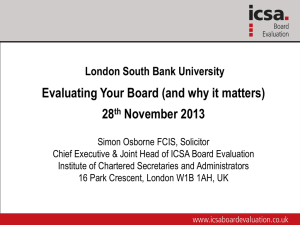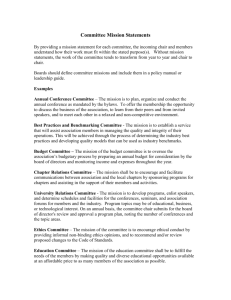Board Corporate Governance Charter
advertisement

Version 5 approved by Board 27 May 2011 Standards Australia Limited Board Corporate Governance Charter 1. Introduction Standards Australia Limited is a public company limited by guarantee and incorporated in New South Wales. It was registered on 1 July 1999, having been formed from Standards Association of Australia, a body incorporated by Royal Charter in 1950 that had commenced operations in 1922. Standards Australia Ltd as a company limited by guarantee, has Members rather than shareholders. The business of the Company is to be managed by or under the direction of the Directors (Corporations Act s198 A (1)). 2. Governance Corporate Governance is ‘the system by which companies are directed and controlled’, and this Charter is to be read in conjunction with the Constitution and the Corporations Act. 2.1 Members In accordance with the Constitution the Company’s Members are drawn from those bodies and organisations most involved in the development and utilisation of Standards. As well as their responsibilities under the Corporations Act, Members may appoint one (or in some cases, more) Councillor to represent them in accordance with criteria that reflect the Member’s involvement in the core activity of Standards development. 2.2 Councillors Councillors are appointed by Members to represent their views in Council, which independently advises the Board of matters of concern to stakeholders. Under the Constitution Councillors are delegated authority by Members to elect the Chairman of the Board, Directors, and Members of the Accreditation Board for Standards Development Organisations. 2.3 Board 2.3.1 Roles The principal roles of the Board as a collective body are: To review and approve the strategic direction, as detailed in the long term corporate strategy and the annual business plan with achievable and measurable targets and milestones. To review and approve budgets and other performance indicators and review performance against them, initiating corrective action where required. Oversight of the company, accountability systems. including its control and 2 To approve policies ensuring compliance with applicable laws and the highest business and ethical standards. To appoint and evaluate the ongoing performance against predetermined criteria of the Chief Executive Officer. To review and approve the total remuneration of the Chief Executive Officer. To review the structure and composition of the Board and Board Committees to ensure the most effective structure that best assists the governance process. To test by questioning and challenging management assertions and by requiring that the Board be kept fully informed of operational and financial performance. To review and approve business plans and budgets, ensuring they are in accord with and support the established objectives and approved strategies. To approve and monitor the progress of major capital expenditure, investment management, and acquisitions and divestitures. To ensure that policies on key issues, including exposure to various risks, are in place and are appropriate. To review and ratify systems of risk management internal compliance and control, codes of conduct legal compliance. To recommend the appointment of auditors and to oversee the audit process and review audit reports. Require and monitor systems for keeping key stakeholders informed. and and 2.3.2 Matters reserved for the Board: Approval of strategy, business plans and objectives, and monitoring of performance against them. Approval of annual statutory financial statements and reports. Major contracts. Approval of acquisitions/disposals of subsidiaries/divisions/operations. Capital expenditure above delegated limits. Board membership and appointments; review of Board, Committee and CEO performance; appointment/removal of CEO. Appointment and terms of reference of Board Committees. Delegation of authority to CEO, Company Secretary and management. Board Charter V5 approved by Board 27 May 2011 3 Remuneration policy for Company; remuneration of Directors and CEO. Corporate governance principles and practice, Codes of Practice or conduct. Making of political donations and policy for charitable donations. Appointment/recommendations of auditors and principal professional advisers. Approval of major policies such as taxation, health and safety, environmental, continuous disclosure and communications. 2.4 Directors Directors are to act at all times with due care and diligence in discharging their duties and fiduciary responsibilities under the Corporations Act (and in compliance with The Board Code of Conduct). Directors decide what matters are delegated to management and what controls are in place to oversee the operation of these delegated powers. 2.4.1 Chairman of the Board The Chairman of the Board is elected by the Councillors for a term of three years and will be non-executive and independent of the role of Chief Executive Officer. The Chairman is responsible for leadership of the Board, for the efficient organisation and conduct of the Board’s function, and for the briefing of all Directors in relation to issues arising at Board meetings. It is important that the Chairman facilitate the effective contribution of all Directors and promote constructive and respectful relations between Directors and management. It is vital that the Chairman commit the time necessary to discharge that role effectively. In that context the number of other positions held, and time commitment associated with them, should be taken into account. 2.4.2 Role of the Chief Executive Officer The Chief Executive Officer is responsible to the Board for the leadership, management and overall Company performance. The Chief Executive Officer manages the Company in accordance with the strategy, plans and policies approved by the Board to achieve agreed goals. In particular the Chief Executive Officer’s responsibilities include: Taking and approving all and any actions and initiatives required to deliver the Company’s strategy, mission, vision and operating plans approved by the Board Board Charter V5 approved by Board 27 May 2011 4 Ensuring all risks are identified and managed Maintaining an effective management team Managing expenditures within approved limits and budgets Ensuring that all actions comply with Company policies and standards in force from time to time Ensuring that the Board is made aware of any significant issues that effect the Company’s wellbeing Other responsibilities as delegated from time to time by the Board 2.4.3 Role of the Company Secretary The Company Secretary plays an important role in supporting the effectiveness of the Board by monitoring that Board policy and procedures are followed, and coordinating the completion and dispatch of Board Meeting agenda and briefing materials. The Company Secretary is accountable to the Board, through the Chairman, on all governance matters. 3. Board Structure 3.1. Board Composition and Size In accordance with the Constitution the Board shall comprise a minimum of 6 and a maximum of 11 Directors including the Chief Executive Officer. The majority of the non-executive Directors should be independent with no significant ties with the Company that could affect their judgement. The majority of Directors are elected by the Councillors on behalf of the Members for a term of three years. The Board may appoint up to 2 Directors (in addition to the Chief Executive Officer). Members, by resolution passed in a General Meeting, or the Council in a Council Meeting, may remove any Director before the end of the Director’s term of office and appoint another person in the Director’s place. 3.2. Appointments to the Board Directors are usually appointed for a term of 3 years. Elections are held annually for the position of those Directors whose term has ended. The Constitution and Membership Rules set out the procedures for the conduct of the elections. Directors may be appointed by the Board, or by Councillors (on behalf of Members). For a person to be nominated for election by Councillors as a Director, the nomination must be in accordance with the Constitution and Membership Rules. Providing the Directors appointed by the Councillors remains a clear majority, the Board may elect up to two Directors of its own choosing having due regard to the commercial requirements Board Charter V5 approved by Board 27 May 2011 5 of the Company. A Director appointed by the Board will hold office until the next election of Directors. 3.3. Tenure Directors serve for a term of 3 years upon election and may be reappointed for a maximum of two further subsequent terms of 3 years. A director that has served for 9 years shall not be eligible for election until a period of absence of at least 6 years. After that period of absence the director shall be eligible for re-election for two further subsequent terms of 3 years each. No director shall serve for more than a total of 15 years. The position of Chairman is for a term of 3 years and may be extended by re-election for one further term of 3 years. If a Director is Chairman at the conclusion of 9 consecutive years as a Director (including time served as Chairman) he may continue as Chairman until the earlier of: the expiry of 12 consecutive years as a Director (including time as Chairman), or the expiry of 6 years as Chairman. It is expected that the Chairman will communicate their intention to the Board in respect of retirement at an appropriate time so that a smooth changeover can be effected. The Board may appoint one of the Directors as Deputy Chairman, to act for the Chairman as required and to provide a potential line of succession. 3.4. Board Committees To consider issues in more detail the Board can establish Board Committees, which then report back and advise the Board. In addition, ad hoc Committees may be formed for specific tasks. Each Committee has its own Charter approved by the Board. The Board will appoint a Director to Chair each Committee. Directors are expected to make themselves available to serve on Committees as required. The Chief Executive Officer will attend Committee meetings by invitation. Directors not appointed as Members of a Committee should consult with and gain the concurrence of the Committee Chairman prior to attending any Committee meetings. The chairman of each Committee will report matters of significance to the next Board meeting for approval or ratification. A copy of Committee minutes, or a written summary report, should be submitted to the Board for noting. The Company Committees. Secretary maintains Charters for each of the The role of each Committee is as follows: 3.4.1 Finance & Audit Committee The Finance & Audit Committee is to act as the medium by which the Board, management, and auditors will meet, review and Board Charter V5 approved by Board 27 May 2011 6 advise on matters relating to financial management, risk and compliance. The primary objectives of the Committee are to assist the Board in fulfilling its responsibilities relating to: Investment strategy Risk management Compliance with legal and contractual obligations Accounting and reporting practices; The Finance & Audit Committee also monitors the Company’s relationship with external auditors and recommends auditor appointments and terminations, and approves fees. 3.4.2 Remuneration & Nominations Committee The primary objectives and roles of the Remuneration & Nominations Committee are to assist the Board in fulfilling its responsibilities in relation to: Overall remuneration policy and strategy ensuring it reflects the needs of all stakeholders and the principles of good corporate governance. Reviewing and recommending the Chief Executive Officer’s remuneration package and performance against agreed objectives. Reviewing and remuneration. recommending Nomination of Committees. new Succession planning for the Board, Board Committees and the CEO. Nomination of Councillors, including Life Councillors. Applications for new Standards Australia Members. Ensuring appropriate processes are in place for Board and Board Committee performance evaluation. Directors adjustments and to Directors’ appointees to Board 3.4.3 Strategy Committee The primary objective of the Strategy Committee is to assist the Board in considering and setting the Company’s overall strategic direction and objectives. 3.4.4 Standards Development Committee The Standards Development Committee’s primary role is to assist the Board in the development of Australian Standards, which include joint Australian / New Zealand Standards, and related documents, in particular to: Board Charter V5 approved by Board 27 May 2011 7 Exercise oversight of the Company’s processes, policies and procedures as a developer of Australian Standards and related documents. Provide process governance for the development of Australian Standards by the Company, and as agreed on a case by case basis for other accredited Standards Development Organisations as required, and to ensure compliance with appropriate processes for the development of Australian Standards. Determine which projects are resourced by Standards Australia, with reference to published criteria. Provide guidance on, and if necessary make decisions on, priorities for the development of Australian Standards and other documents in the public interest. Provide the final point of process dispute resolution within SA as a developer of Australian Standards and related documents. 4. Board Processes 4.1 Board Meetings The schedule of dates for Board and Committee meetings will be agreed one year ahead. The Board meets approximately 5 times per year. 4.2. Board Agenda The Company Secretary will prepare the agenda for each Board meeting in conjunction with the Chief Executive Officer and the Chairman. Directors have the right and duty to have included on the agenda items of concern to them. 4.3 Board Papers Where possible material for Board meetings will be forwarded to Directors at least 5 working days prior to the Board meeting. 4.4. Board Minutes/Action Points Minutes are recorded for every meeting of the Board and Board Committees. The minutes will be prepared in draft by the Company Secretary, who will consult the Chief Executive Officer, and they will then be provided to the Chairman / Committee Chairman for approval. The approved draft minutes will be forwarded to all Directors / Committee Members who should advise the Chairman or Secretary of any suggested changes. The minutes will be Included in the papers of the next Board / Committee Meeting for formal approval. A permanent Minute Book of all signed Minutes will be retained. 4.5. Board Resolutions All Board resolutions must be recorded in the minutes, Where decisions are required between Board meetings, these may be made by circular resolution approved by all Directors, in Board Charter V5 approved by Board 27 May 2011 8 accordance with the Constitution. Circular resolutions should be formally ratified at the next Board meeting. A brief summary of Board decisions and resolutions, bearing in mind confidentiality, will be communicated to management as soon as practical after a Board meeting. 4.6. Delegations of Authority The Board approves delegations of authority to Board Committees (by way of Committee Charters) and to the Chief Executive Officer. The delegations are reviewed by the Board at least annually. 4.7 Agreements entered on behalf of the Company Agreements and contracts entered into by the Company are often required to be signed by two Directors, or by one Director and the Company Secretary. [This is equivalent to the old practice of execution of documents under Common Seal, however following changes to the Corporations Act (S 127) such executions do not require the affixation of the Company Seal unless required under the Constitution (it is not a requirement of the Company’s current Constitution)]. In practice most documents requiring execution are signed on behalf of the Company by the Chief Executive Officer (as a Director) and the Company Secretary. Signatories are required to have read or have been appropriately briefed on the contents of the document and must only sign if they – Are satisfied that they understand and accept the conditions and consequences of the document. Are comfortable that the Board has agreed or would be agreeable for the document to be executed. Are confident they are authorised to execute the document. A copy of all documents executed is retained by the Company Secretary who also maintains a Documents Execution Register summarising the executions. Details of executions are reported to each Board meeting. Board Charter V5 approved by Board 27 May 2011









